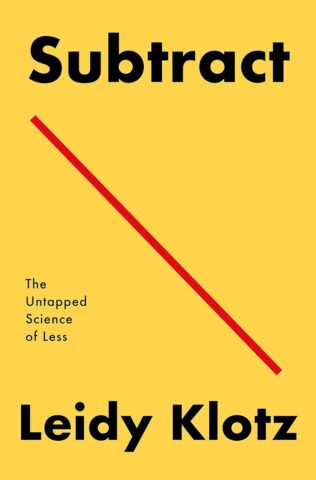I can say, without a doubt, that no book better sums up the work I’ve done for the last 15 years better than Subtract. It’s focus on removing elements as opposed to adding new ones to get out of ruts, solve challenges, etc., is music to my consultant’s ears. My days are very often spent telling clients to either stop doing something that is not working or do less of something that was working but that has stalled. The is real value in adopting a less is more mindset for small businesses.
With Subtract, author Leidy Klotz embarks on a thought-provoking journey through the often overlooked concept of subtraction. That is, when we run into a challenge, whether at work or at home, take a step back and consider what can be removed to bring about a speedy solution. While that might sound simple, it’s the reverse of what most people and businesses do. More often than not our first thought is often “What can I add?”
Klotz, with his engaging narrative and rigorous research, makes a compelling case for subtraction as a tool not only for simplifying our lives but also for enhancing creativity, efficiency, and sustainability.
Subtracting elements brings about clarity
One of my favorite examples from the book involves a Lego bridge, which the author was building with his son. When they realized that the sides of the bridge were uneven, Klotz attacked the remedy by adding more supports; his son did the opposite, removing unnecessary supports, which shortened the longer side, making the bridge level. The author was gobsmacked that he hadn’t seen the remedy from his son’s vantage point.

Another example in the book involves the iPhone, as Klotz shares how the removal of unnecessary features during the design phase led to a product that was more user-friendly and, most importantly, became a more visual appealing, elegant product, which was a boon for a company debuting a product in a category littered with established options.
“We humans neglect an incredibly powerful option,” he writes. “We don’t subtract. We pile on to-dos, but don’t consider stop doings. We create incentives for high performance, but don’t get rid of obstacles to our goals. We draft new laws without getting rid of outdated legislation. … We systematically opt for more, not less.”
Removing elements allows you to see challenges more clearly
I found myself nodding along throughout the book, which contains example after relevant example of how removing options led to a better result. Maybe my favorite example involves The Embarcadero in San Francisco. One of the most iconic and most visited places in the city didn’t exist until the Loma Prieta earthquake of 1989 destroyed the Embarcadero Freeway that previously ran along the waterfront.
Despite concerns from what was previously seen as a critical loss of traffic, removal of the highway opened the door to a thriving marketplace bustling with dozens of retail and dining options, and myriad pedestrians daily. Stanford psychologist Robert Sutton, who was interviewed recently by Adam M. Grant on his “Think Again” gave a brilliant exposition of why humans refrain from removing the excess and the subsequent hassles it leads to.
“We, as human beings, our default way of solving problems is just to add more complexity, to add more people, to add more stuff. And by the way, our organizations even reward us for doing that stuff, for having bigger staffs, for starting new initiatives. And just think more, uh, of yourself as sort of an editor in chief. What do great editors do? They cross things out, they make things shorter. So I would just start by, anytime you’re going to solve a problem, start something new, pause and remember that you are wired to want to add complexity rather than to subtract it or not add it in the first place.”
A final word on subtraction
I highly recommend Subtract to anyone interested in finding more and better ways to declutter their life, mind, work. Klotz’s engaging storytelling and solid research make for an enlightening read that promises to change how you think about problem-solving and innovation.


